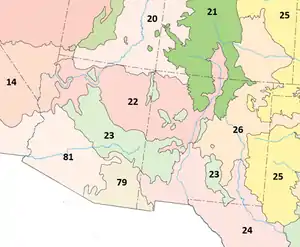Arizona/New Mexico Mountains ecoregion
The Arizona/New Mexico Mountains ecoregion is a Level III ecoregion designated by the United States Environmental Protection Agency (EPA) in the U.S. states of Arizona and New Mexico.
| Arizona/New Mexico Mountains ecoregion | |
|---|---|
 The Arizona/New Mexico Mountains (23), monotypic ecoregion of the Temperate Sierras |
Description
The region is a transition region from the lower elevation Sonoran Desert (81) to the southwest and Chihuahuan Desert (24) southeast; the west is bordered by the mid elevation Mojave Desert (14).
The north is bordered by the east-west Arizona/New Mexico Plateau (22), ecoregion which is part of and is the southern region of the Colorado Plateau. The north region of the Colorado Plateau covers eastern Utah/western Colorado and is the Colorado Plateaus (ecoregion) (20). The extreme southern perimeter of the Colorado Plateaus ecoregion extends east-west along the border regions of Arizona-New Mexico.
Arizona section
The Arizona section is bordered on the north, and center by regions of the Mogollon Rim, extending on the east into western New Mexico. It is named the Arizona transition zone[1] and contains the following mountains:
Central mountain ranges
- Black Hills (Yavapai County)
- Dripping Springs Mountains
- Limestone Hills (Arizona)
- Mazatzal Mountains
- New River Mountains
- Sierra Ancha
- Superstition Mountains
- Usery Mountains
Western region ranges
- Aquarius Mountains
- Black Hills (Yavapai County)
- Black Mountains (Yavapai County)
- Bradshaw Mountains
- Date Creek Mountains
- Hieroglyphic Mountains
- Juniper Mountains
- McCloud Mountains
- Mohon Mountains
- Poachie Range
- (Alamo Lake, Aguila Valley)
- Santa Maria Mountains
- Sierra Prieta
- Sullivan Buttes
- Vulture Mountains
- Weaver Mountains
Eastern region ranges
- Big Lue Mountains
- Black Hills (Greenlee County)
- Blackjack Mountains
- Gila Mountains (Graham County)
- Hayes Mountains
- Mescal Mountains, Arizona
- Natanes Mountains
- Pinal Mountains
- Salt River Mountains (Gila County)
- Santa Teresa Mountains
- Sevenmile Mountains, Arizona
- Sierra Aguilada-(New Mexico)
- White Mountains (Arizona)-(central-southern regions)
In Arizona, two outlier regions are also considered as part of the ecoregion, the Kaibab Plateau, (the North Rim of the Grand Canyon), and the Chuska Mountains region of the northeast of Northern Arizona.
New Mexico section
The New Mexico section contains the mountain ranges that extend eastwards into western New Mexico from the Arizona transition zone. The White Mountains subregion of eastern Arizona is a high altitude area extending into about ten ranges of western-(central) New Mexico, and west of the Rio Grande. East of the Rio Grande and extending southeast is a monolithic section of mountains, mostly the Sacramento Mountains but extending southeast into the Guadalupe Mountains.
In the central-north, east of the Rio Grande another monolithic section is made of the Sandia-Manzano Mountains. West of the Rio Grande extending northwest towards the Chuskas, on the Arizona-New Mexico border, are other outlier ranges considered part of the Arizona/New Mexico Mountains ecosystem.
See also
- List of mountain ranges of Arizona
- List of mountain ranges of New Mexico
- Ecoregions defined by the EPA and the Commission for Environmental Cooperation:
- The conservation group World Wildlife Fund maintains an alternate classification system:
References
- Luchhitta, 2001. Hiking Arizona's Geology, Part 2, "Map Graphic": Arizona Transition Zone, p. 143-145. (and Hikes: 18-26, p. 145-182.)
- Lucchitta, 2001. Hiking Arizona's Geology, Ivo Lucchitta, c 2001, Mountaineers's Books. 272 pages, 41 Hikes. (softcover, ISBN 0-89886-730-4)